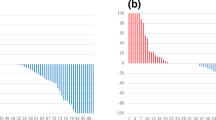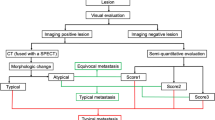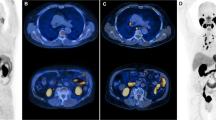Abstract
Background:
To evaluate PSA levels and kinetic cutoffs to predict positive bone scans for men with non-metastatic castration-resistant prostate cancer (CRPC) from the Shared Equal Access Regional Cancer Hospital (SEARCH) cohort.
Methods:
Retrospective analysis of 531 bone scans of 312 clinically CRPC patients with no known metastases at baseline treated with a variety of primary treatment types in the SEARCH database. The association of patients’ demographics, pathological features, PSA levels and kinetics with risk of a positive scan was tested using generalized estimating equations.
Results:
A total of 149 (28%) scans were positive. Positive scans were associated with younger age (odds ratio (OR)=0.98; P=0.014), higher Gleason scores (relative to Gleason 2–6, Gleason 3+4: OR=2.03, P=0.035; Gleason 4+3 and 8–10: OR=1.76, P=0.059), higher prescan PSA (OR=2.11; P<0.001), shorter prescan PSA doubling time (PSADT; OR=0.53; P<0.001), higher PSA velocity (OR=1.74; P<0.001) and more remote scan year (OR=0.92; P=0.004). Scan positivity was 6, 14, 29 and 57% for men with PSA<5, 5–14.9, 15–49.9 and ⩾50 ng ml−1, respectively (P-trend <0.001). Men with PSADT ⩾15, 9–14.9, 3–8.9 and <3 months had a scan positivity of 11, 22, 34 and 47%, correspondingly (P-trend <0.001). Tables were constructed using PSA and PSADT to predict the likelihood of a positive bone scan.
Conclusions:
PSA levels and kinetics were associated with positive bone scans. We developed tables to predict the risk of positive bone scans by PSA and PSADT. Combining PSA levels and kinetics may help select patients with CRPC for bone scans.
This is a preview of subscription content, access via your institution
Access options
Subscribe to this journal
Receive 4 print issues and online access
$259.00 per year
only $64.75 per issue
Buy this article
- Purchase on Springer Link
- Instant access to full article PDF
Prices may be subject to local taxes which are calculated during checkout



Similar content being viewed by others
References
Derleth CL, Yu EY . Targeted therapy in the treatment of castration-resistant prostate cancer. Oncology 2013; 27: 620–628.
Schellhammer PF, Chodak G, Whitmore JB, Sims R, Frohlich MW, Kantoff PW . Lower baseline prostate-specific antigen is associated with a greater overall survival benefit from sipuleucel-T in the immunotherapy for prostate adenocarcinoma treatment (IMPACT) trial. Urology 2013; 81: 1297–1302.
Nelius T, Reiher F, Lindenmeir T, Klatte T, Rau O, Burandt J et al. Characterization of prognostic factors and efficacy in a phase-II study with docetaxel and estramustine for advanced hormone refractory prostate cancer. Onkologie 2005; 28: 573–578.
Kantoff PW, Higano CS, Shore ND, Berger ER, Small EJ, Penson DF et al. Sipuleucel-T immunotherapy for castration-resistant prostate cancer. N Engl J Med 2010; 363: 411–422.
Basch E, Autio K, Ryan CJ, Mulders P, Shore N, Kheoh T et al. Abiraterone acetate plus prednisone versus prednisone alone in chemotherapy-naive men with metastatic castration-resistant prostate cancer: patient-reported outcome results of a randomised phase 3 trial. Lancet Oncol 2013; 14: 1193–1199.
Beer TM, Armstrong AJ, Rathkopf DE, Loriot Y, Sternberg CN, Higano CS et al. Enzalutamide in metastatic prostate cancer before chemotherapy. N Engl J Med 2014; 371: 424–433.
Slovin SF, Wilton AS, Heller G, Scher HI . Time to detectable metastatic disease in patients with rising prostate-specific antigen values following surgery or radiation therapy. Clin CancerRes 2005; 11: 8669–8673.
Okotie OT, Aronson WJ, Wieder JA, Liao Y, Dorey F, De KJ et al. Predictors of metastatic disease in men with biochemical failure following radical prostatectomy. J Urol 2004; 171: 2260–2264.
Dotan ZA, Bianco FJ Jr., Rabbani F, Eastham JA, Fearn P, Scher HI et al. Pattern of prostate-specific antigen (PSA) failure dictates the probability of a positive bone scan in patients with an increasing PSA after radical prostatectomy. J Clin Oncol 2005; 23: 1962–1968.
Loeb S, Makarov DV, Schaeffer EM, Humphreys EB, Walsh PC . Prostate specific antigen at the initial diagnosis of metastasis to bone in patients after radical prostatectomy. J Urol 2010; 184: 157–161.
Moreira DM, Cooperberg MR, Howard LE, Aronson WJ, Kane CJ, Terris MK et al. Predicting bone scan positivity after biochemical recurrence following radical prostatectomy in both hormone-naive men and patients receiving androgen-deprivation therapy: results from the SEARCH database. Prostate Cancer Prostatic Dis 2014; 17: 91–96.
Allott EH, Abern MR, Gerber L, Keto CJ, Aronson WJ, Terris MK et al. Metformin does not affect risk of biochemical recurrence following radical prostatectomy: results from the SEARCH database. Prostate Cancer Prostatic Dis 2013; 16: 391–397.
Scher HI, Halabi S, Tannock I, Morris M, Sternberg CN, Carducci MA et al. Design and end points of clinical trials for patients with progressive prostate cancer and castrate levels of testosterone: recommendations of the Prostate Cancer Clinical Trials Working Group. J Clin Oncol 2008; 26: 1148–1159.
Hamilton RJ, Aronson WJ, Terris MK, Kane CJ, Presti JC Jr., Amling CL et al. Limitations of prostate specific antigen doubling time following biochemical recurrence after radical prostatectomy: results from the SEARCH database. J Urol 2008; 179: 1785–1789; discussion 1789-1790.
Wright JL, Salinas CA, Lin DW, Kolb S, Koopmeiners J, Feng Z et al. Prostate cancer specific mortality and Gleason 7 disease differences in prostate cancer outcomes between cases with Gleason 4+3 and Gleason 3+4 tumors in a population based cohort. J Urol 2009; 182: 2702–2707.
Freedland SJ, Humphreys EB, Mangold LA, Eisenberger M, Dorey FJ, Walsh PC et al. Risk of prostate cancer-specific mortality following biochemical recurrence after radical prostatectomy. JAMA 2005; 294: 433–439.
Cookson MS, Roth BJ, Dahm P, Engstrom C, Freedland SJ, Hussain M et al. Castration-resistant prostate cancer: AUA Guideline. J Urol 2013; 190: 429–438.
Smith MR, Kabbinavar F, Saad F, Hussain A, Gittelman MC, Bilhartz DL et al. Natural history of rising serum prostate-specific antigen in men with castrate nonmetastatic prostate cancer. J Clin Oncol 2005; 23: 2918–2925.
Smith MR, Cook R, Lee KA, Nelson JB . Disease and host characteristics as predictors of time to first bone metastasis and death in men with progressive castration-resistant nonmetastatic prostate cancer. Cancer 2011; 117: 2077–2085.
Smith MR, Saad F, Oudard S, Shore N, Fizazi K, Sieber P et al. Denosumab and bone metastasis-free survival in men with nonmetastatic castration-resistant prostate cancer: exploratory analyses by baseline prostate-specific antigen doubling time. J Clin Oncol 2013; 31: 3800–3806.
Davis NB, Ryan CW, Stadler WM, Vogelzang NJ . A phase II study of nilutamide in men with prostate cancer after the failure of flutamide or bicalutamide therapy. BJU Int 2005; 96: 787–790.
Acknowledgements
This study was funded by the Department of Veterans Affairs, National Institutes of Health grant R01CA100938 (WJA), NIH Specialized Programs of Research Excellence grant P50 CA92131-01A1 (WJA), the Georgia Cancer Coalition (MKT), NIH K24 CA160653 (SJF) and Amgen.
Disclaimer
Views and opinions of, and endorsements by, the author(s) do not reflect those of the US Army or the Department of Defense.
Author information
Authors and Affiliations
Corresponding author
Ethics declarations
Competing interests
AL is employed by Amgen. The remaining authors declare no conflict of interest.
Additional information
Supplementary Information accompanies the paper on the Prostate Cancer and Prostatic Diseases website
Supplementary information
Rights and permissions
About this article
Cite this article
Moreira, D., Howard, L., Sourbeer, K. et al. Predicting bone scan positivity in non-metastatic castration-resistant prostate cancer. Prostate Cancer Prostatic Dis 18, 333–337 (2015). https://doi.org/10.1038/pcan.2015.25
Received:
Revised:
Accepted:
Published:
Issue Date:
DOI: https://doi.org/10.1038/pcan.2015.25
This article is cited by
-
Does whole-body bone SPECT/CT provide additional diagnostic information over [18F]-FCH PET/CT for the detection of bone metastases in the setting of prostate cancer biochemical recurrence?
Cancer Imaging (2020)
-
Impact of age, comorbidity, and PSA doubling time on long-term competing risks for mortality among men with non-metastatic castration-resistant prostate cancer
Prostate Cancer and Prostatic Diseases (2019)
-
Do skeletal-related events predict overall survival in men with metastatic castration-resistant prostate cancer?
Prostate Cancer and Prostatic Diseases (2016)



